The Cool City That German Tourists Keep to Themselves
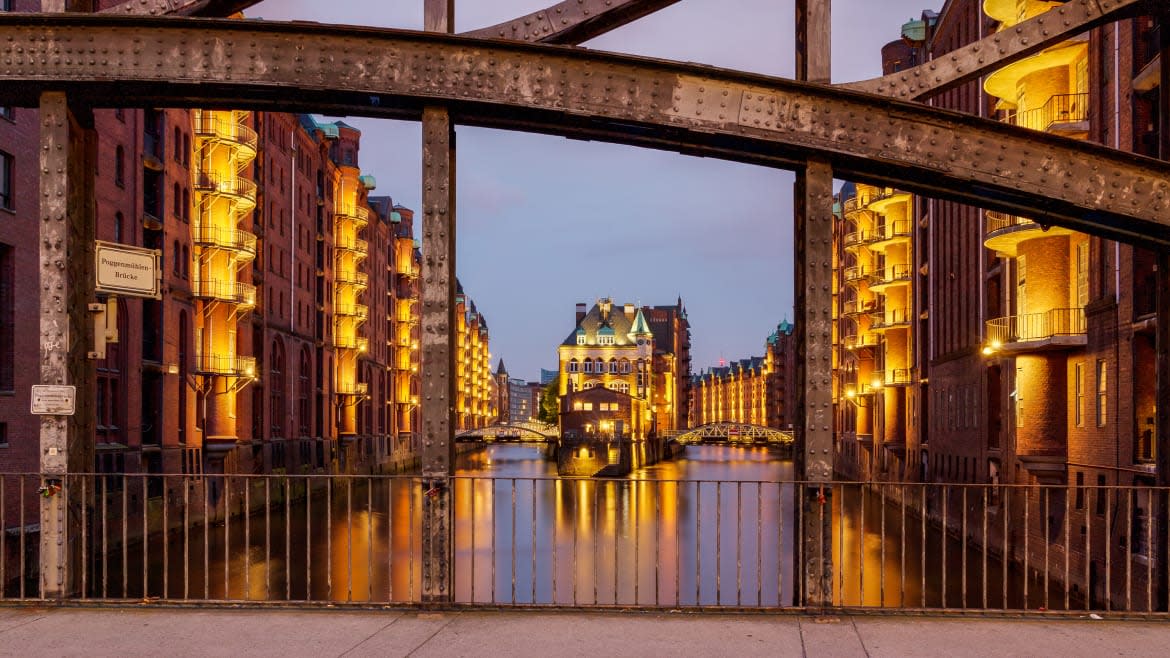
Falling in love with a city in September is like falling in love with a FaceTuned Tinder photo—the weather is just too good, the population too refreshed from summer and their kids being back in school. But if you find yourself charmed by a place in the depths of winter, say, a blustery rainy long weekend in February, and still want to go back—you know it’s the real deal.
Such was my experience just a couple of weeks ago in Hamburg, Germany, where for four days I visited in the rain. It’s the country’s second largest city and the seventh largest in the EU. However, it’s one that, other than to conduct business, Americans rarely visit. A perfect fit, then, for our series on underrated destinations, It’s Still a Big World.
Charmed is precisely what I was after my four days there. Whether it’s architecture, music, food, history, or urban curiosity that motivates you, Hamburg has something for everybody. And, as it’s a city focused more on work and play for its own citizens and not for non-German tourists, there is a sense that as a total foreigner you’re experiencing a place, a way of life, relatively unscathed by our tourism.
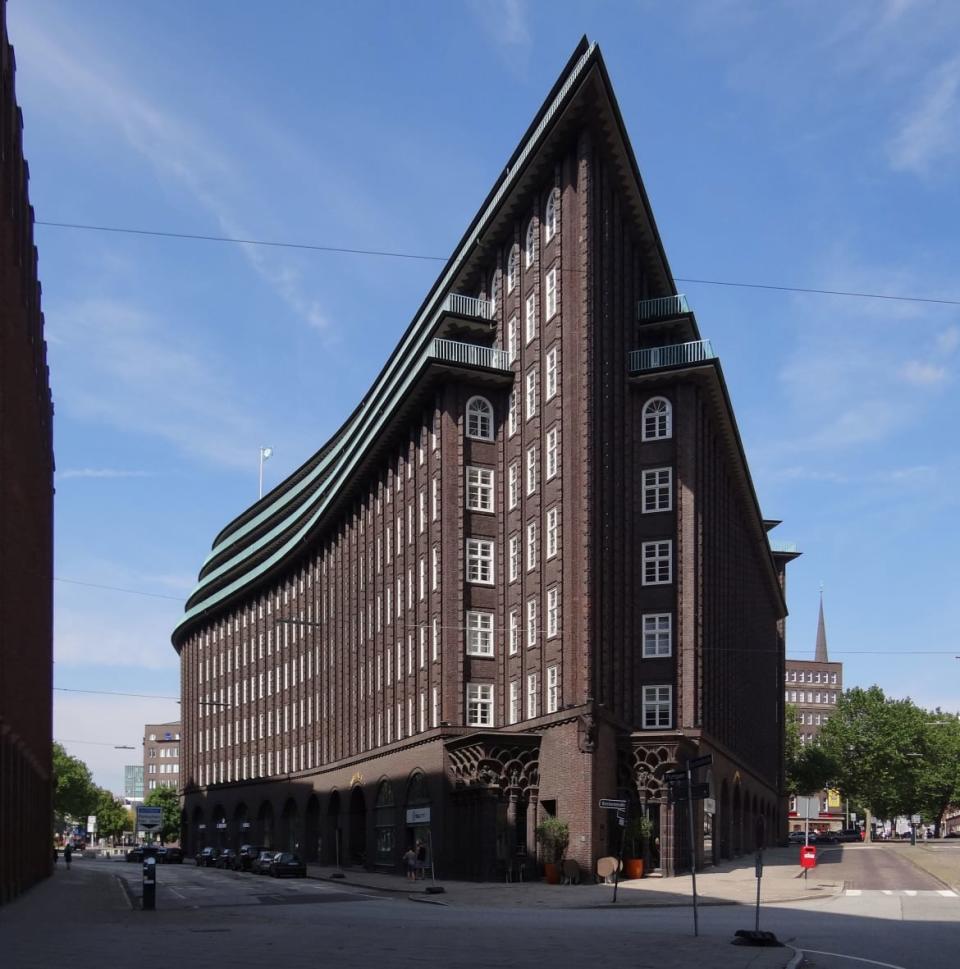
Chilehaus
The Free and Hanseatic City of Hamburg, as it is formally known, sits in the north of Germany near Denmark, where the rivers Elbe and Alster meet. For centuries it was at the center of a loose confederation of free city states called the Hanseatic League that dominated trade in Northern Europe and the North and Baltic Seas. While its status as a completely independent entity went away long ago, it still sees itself as apart. Some refer to it as “the southernmost Scandinavian city” and native son Karl Lagerfeld once said he felt Hanseatic first, German second. As home to some of the highest concentrations of millionaires and billionaires in Germany, its leafy upscale neighborhoods have plenty of mansions, but they’re often in Anglo styles like Victorian or Georgian.
Mexico’s Hot New Wine Region Is a History Lover’s Dream
While it may not bring in Americans, Germans love Hamburg. It’s the world’s third largest musical theater market, with German-language reproductions of The Lion King, Frozen, and Hamilton. Its port, the country’s largest, is a draw. And the odd but overwhelming collection of large-scale miniature cities at Miniatur Wunderland—a place few Americans other than model train enthusiasts have heard of—is often rated Germany’s most popular attraction, higher than Neuschwanstein.
A light drizzle greeted me after a complicated train ride from Amsterdam. Hamburg’s biggest obstacle as a tourist destination is the lack of connections. The sole direct flight from the U.S., operated by Emirates, ended a few years ago, and there’s no direct train from Amsterdam, leaving you especially vulnerable to the vagaries of the Deutsche Bahn—in my case, their decision to park a cargo train without an engine at the only platform available for use along the way.
The walk from the central train station to my hotel in the city’s central business district gave a good taste of what much of this SimCity-like place is like, where all the buildings look like renderings and even when not matching one's taste, are all done with high levels of quality. Throw in the canals that once made this the Venice of the North, and you’ve got a rather exquisite city.
Very little of the city is “historic” in the sense that just one tenth of it is older than a century—the result of Allied bombing and a lack of sentiment when it comes to historic preservation. While there are a few historic buildings, like the neo-Renaissance city hall, most contemporary work pays homage to Hamburg’s great contribution to architectural history—Brick Expressionism.
My hotel was the Renaissance, a standard Marriott but housed in an elaborate Brick Expressionist work by Fritz Höger, one of the style’s giants. Brick Expressionism was a strain of Expressionist architecture, wherein buildings were pulled and contorted past their historical shapes and proportions (Expressionist painters like Munch and Schiele would do the same to the human form). Brick Expressionism, popular in Northern Europe, was distinct in its use of patterns of clinker bricks to create dizzying facades. Höger’s Broschek House, now the Renaissance, was no different with strings of pyramids of gold jutting out from the brick facade.
The hotel was a quick walk to most of the city’s sights, whether the Elbphilharmonie, the Kunsthalle, Hafencity, and Speicherstadt, and a nice stroll to the “cool” neighborhoods of Schanze and Karolinenviertel. Especially close is Höger’s greatest work, the work that was synonymous with the city until the Elbphilharmonie was completed, and the work that made me always want to visit–Chilehaus.
A dream for the visually hungry
Hamburg is a city of business. To walk its streets on a weekday is to see people with their heads down, on a mission. At the turn of the century, its giant merchant and shipping houses built colossal office buildings across the city. The greatest were concentrated just off the canal warehouses in a district that is now a UNESCO heritage site, Kontorhaus.
With the wind ripping through its streets, turning the rain into a sort of rough-day-at-sea spray, I walked around the area with Tomas Kaiser, one of the city’s top guides who is steeped in all things Hamburg. Chilehaus is the most famous of the group, its ocean liner shape being most apparent when standing before its bow: you’d swear it just might come crashing down upon you.
But the neighborhood as a whole is a dream for the visually hungry. Sprinkenhof, just next door, has a facade decorated with diamond-shaped brickwork and circular terracotta sculptures that are meant to be redolent of the Doge’s Palace in Venice. It was Europe’s largest office building when it was completed. It was initially the work of the Jewish brother architects Hans and Oskar Gerson and the aforementioned Fritz Höger, but after the rise of the Nazis, Oskar was not allowed to work on it (Hans died early) and so it was finished by Höger, who had joined the Nazi Party. While you can just wander the neighborhood and easily spot the works, don’t miss Messberghof, Miramar Haus, Bartholomayhaus, and Montanhof.
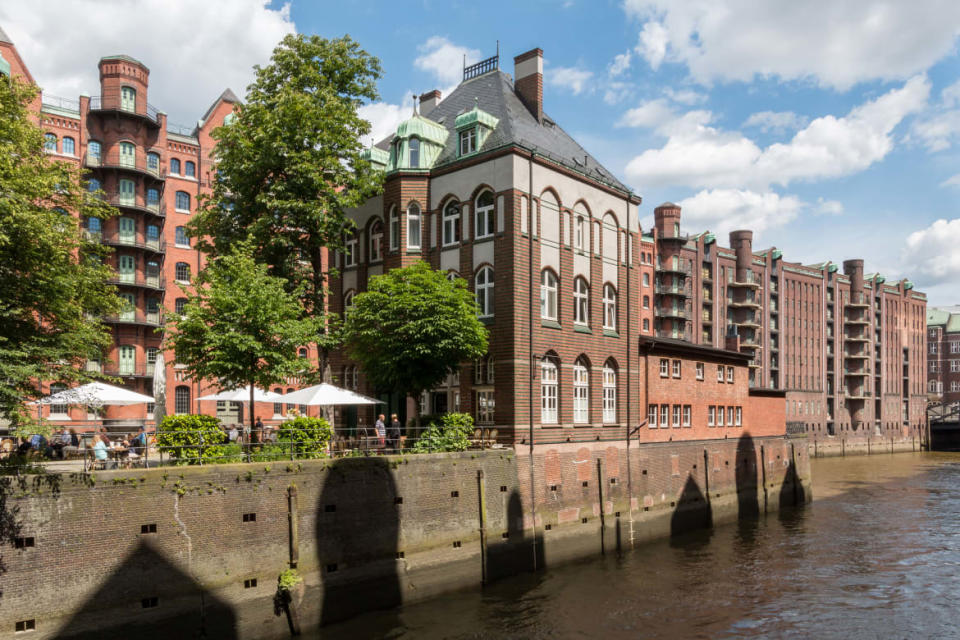
Hamburg, Speicherstadt, Wasserschloss
After the Chilehaus, the site most synonymous with Hamburg is likely its Speicherstadt, the staggering row upon row of warehouses perched on canals that make up the largest waterfront warehouse district in the world. Size isn’t the only impressive thing here, the historic buildings are done in a fetching sort of Flamboyant Gothic Revival and the ones that replaced those destroyed during World War II are a range of Modernist and Postmodern concoctions. While the views down each of the canals are spectacular, sadly they are no longer lit at night due to cost cutting from the Ukraine War. Kaiser showed me old photographs of what the canals and warehouses looked like in their heyday, and you can really see why, with its crush of ships and boats and elaborate buildings on the water, the city was compared with Venice, without being facetious.
After touring the warehouses, Kaiser took me to HafenCity Hamburg, the former docks area where more than 2 square kilometers have been filled in with modern apartments, offices, hotels, and shops–considered the largest urban redevelopment project in Europe. The scale is mind boggling, but it’s provided an opening for interesting entrepreneurs like those behind foodlab, which occupies a couple floors of one of the newer buildings. There, spaces are available for potential restaurateurs, aspiring food video creators, and experimentation. (When I visited, a hummus concept was the pop-up of the moment.) There is a permanent cafe overlooking the river which features items from a variety of tenants they’ve had, and has given training and jobs to Ukrainian women who fled the war.
There is an addendum to the idea that Hamburg is the southernmost Scandinavian city, and it’s that Munich is the northernmost Italian city. That sort of Protestant chauvinism is a funny historical anecdote now (anecdotes being all we care about, not actual history, Karl Lagerfeld once said) but that sort of northern Protestantism is still tangible. On my first night, I ate at Hobenköök, a delightful industrial spot specializing in North German cuisine. If I ever needed a sign that I was in the land of self-abnegation it could have been when the friendly waitress told me I didn’t need the bread to start.
A sort of Protestant commercialism is also evident at one of the city’s other highlights, the Kunsthalle.
“What you are looking at, one could say, is the German Mona Lisa.”
When the communications aide told me this, I grinned, but not because I was so happy to finally see this painting but because Caspar David Freidrich’s The Wanderer Above the Sea isn’t really well known in the U.S. and I thought she was being somewhat tongue in cheek. (A feeling that was reinforced when I posted it to my Instagram with that moniker and every German friend replied with some version of excitement and every American with a snicker.) The painting was revolutionary for the Romantic movement, and its positioning of the wanderer facing away from the viewer, looking out into the possibilities beyond has captured many an imagination. I’d just never heard of it.

The collection as a whole, the museum notes in one of its placards, reflects a community with bourgeois priorities and tastes. So, for instance, there is not a huge collection of over the top Italian Renaissance, Mannerist, and Baroque works. There are, however, a lot of landscapes and still lifes and the like. As the collection progresses into the 19th century, it picks up steam with a number of delightful works you won’t want to miss, from a tiny oil on mahogany by Edgar Degas of a ballet dancer to Ferdinand Hodler’s View into Infinity painting of a nude male youth. The museum also goes out on a limb here and there, for instance by have a room placing the giants of late French 19th-century art (Monet, Manet, Renoir, and Degas) alongside Germans whose work is less well known (Slevogt, Corinth, and Ury). The room of Expressionist work is a key for those looking to compare it to the city’s architecture, so make a beeline for it. Particularly well done are the placards introducing concepts or artists, like that explaining the wily career of Lucas Cranach the Elder, who managed to be best friends with Martin Luther while still getting commissions from Catholic cardinals.
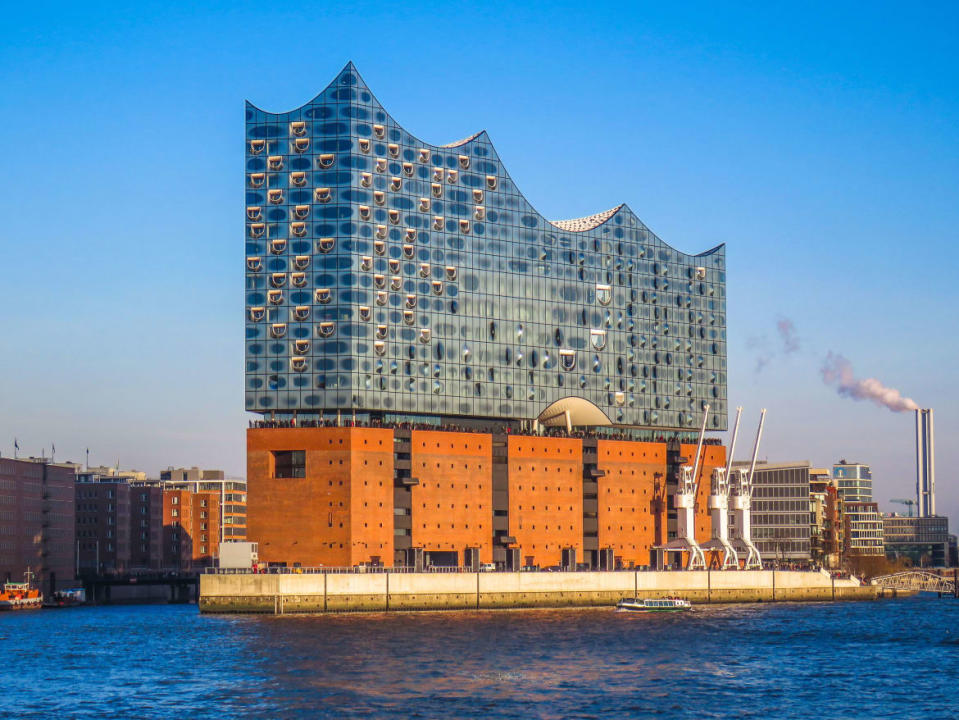
Elbphilharmonie
The highlight of any visit to Hamburg today, though, and reason enough for every traveler to book a trip here, is a concert at the Elbphilharmonie.
The shimmering facade of the Elbphilharmonie is a sort of visual dealer’s choice that it reminds you of… waves, sails, icebergs, your call. The complex comprises three concert halls, a hotel, apartments, restaurants, and a spa. It was built on top of an existing brick warehouse and designed by the famed firm Herzog & de Meuron. Without going too far into the details of its story, let’s just say that the project was intended to cost 250 million euros and ended up costing nearly 900 million euros.
Inside the concert hall is jaw dropping.
I had tickets for a Friday-night show in the main hall in which the Philharmonie Südwestfalen led by Nabil Shehata would perform works by Schubert, Mendelssohn, and Schumann. Before going, I went to dinner at Heldenplatz, a nearby restaurant that is trying to take a casual approach to Michelin star-type dining.
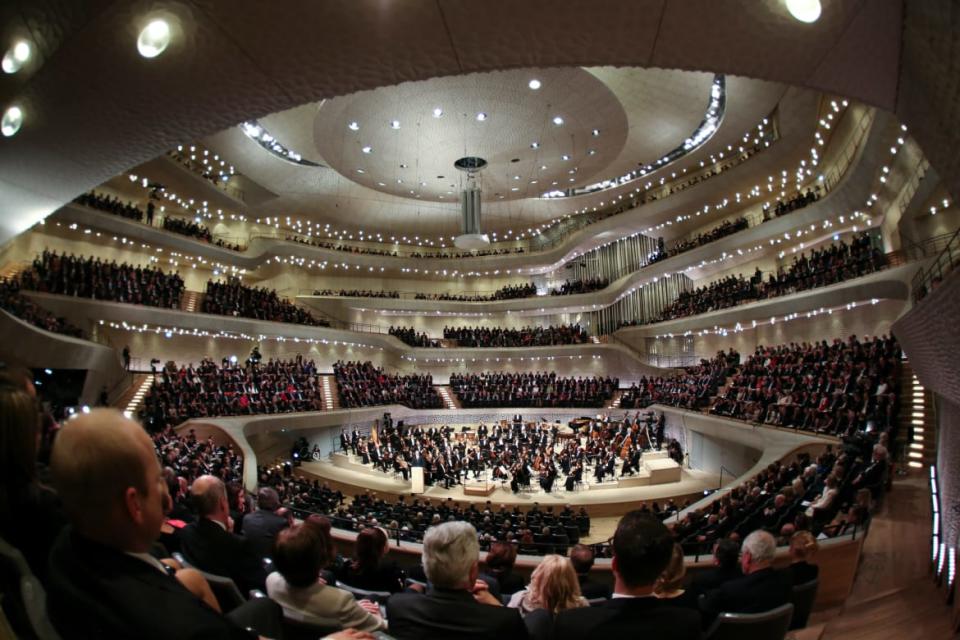
People attend the opening ceremony and concert of the Elbphilharmonie.
It’s recommended you get to the concert a bit earlier than you normally might, because the honeycomb structure inside can be a bit much to navigate—and especially time consuming if you opt to take its famed curved escalator. Inside the concert hall, though, is jaw dropping. The plates covering the walls, engineered by Yasuhisa Toyota, look almost like pebbled leather, and the room just feels immediately cozy and intimate. (My ear is not so finely tuned to have a judgment on the debate about the acoustics, but I will say that once the coughing started it was basically a cacophony.) The solo for Mendelssohn Violin Concerto in E minor, one of my all time favorite compositions, was performed by Michael Barenboim, the son of conductor Daniel Barenboim. Put him under the nepobabies with talent column, because once this bobbing Jay Leno-look alike started playing he cast an absolute spell.
Rounding out the city’s cultural options are three other major museum-type attractions. The first, the city’s history museum, was, alas, closed while I was in town. The second is its Maritime Museum, housed in the city’s oldest standing warehouse. The third is the city’s biggest attraction—Miniatur Wonderland. The complex of miniature model cities, airports, and mountain ranges opened in 2001. When Frederik and Gerrit Braun opened it in 2001, the idea had been to have the world’s largest model railway. Since then it’s grown to have over 50,000 feet of railway across models of cities like Hamburg, Vegas, Rio and stupefying landscapes like the Swiss Alps and the North Sea coast.
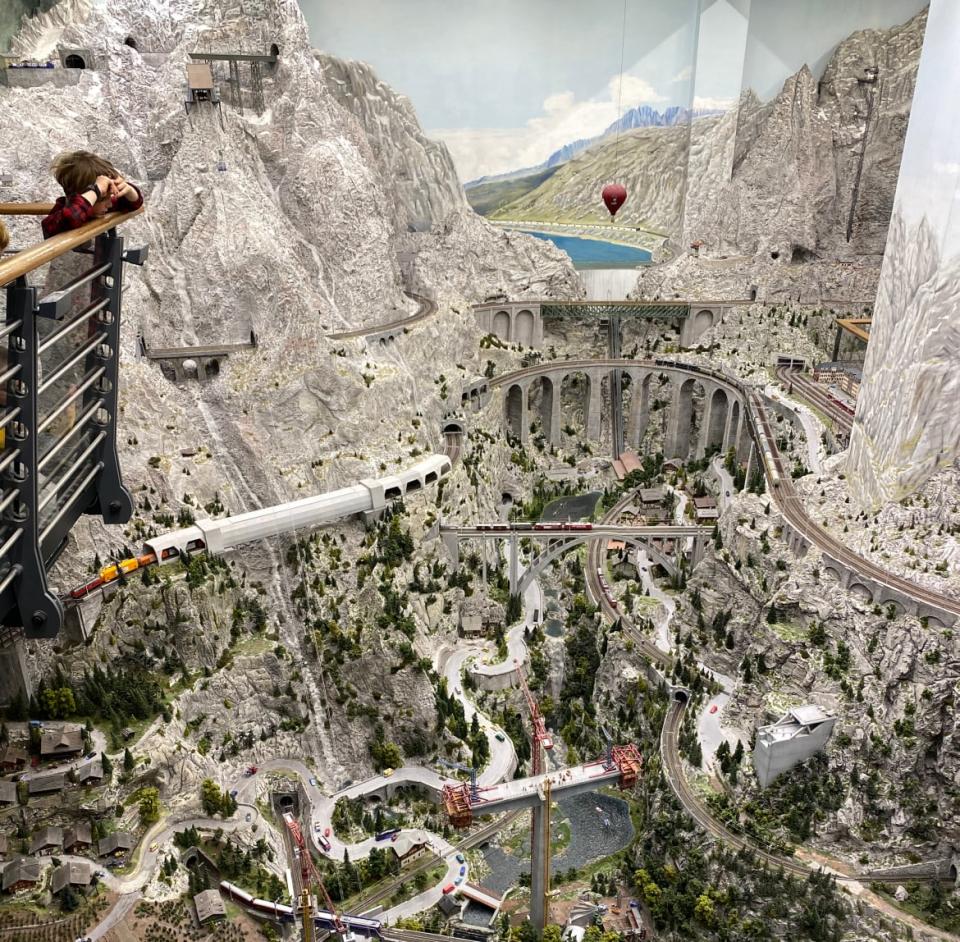
The Swiss Alps recreated at Miniatur Wunderland.
I spent that afternoon wandering the neighborhoods of Schanze and Karolinenviertel, where friends my age in Hamburg lived. Here, the visuals are more Berlin, let’s say, than orderly Hamburg. There is a lot of street art, vintage stores, dive bars, and fewer people in suits. Around the corner from the former Nazi bunker that’s being turned into a hotel, I stopped in for gourmet American-style donuts from Brammibal's. From there I wandered St. Pauli and Große Freiheit, where the Beatles launched their career (Lennon famously said he was born in Liverpool but grew up in Hamburg) and which comes alive at night with an array of neon signage. Transecting it is the famed Reeperbahn, once Hamburg’s famed redlight district avenue where sailors and tourists got up to no good. The party is still going, but it’s less violent and less risque than it once was, and certainly more commercial.
A day exploring in the wet and cold calls for warmth and coziness in the evening. A friend and I started at the M&V Bar, a popular spot that’s technically a gay bar but in the era of openness seemed to be for everybody. From there it was on to neighborhood bistro Cox, one of two stalwarts that people kept recommending to me, along with Vienna Restaurant. Cox was everything you’d hope for in a bistro–food that is comforting but not boring, service that is friendly but not obsequious, and a crowd that all seems to compete for who is going to linger past closing the longest.
We finished the night at Lion Bar, a popular spot back toward the commercial center of the city, which means that if you get there and there’s no room you will likely stick around and wait because there’s nothing else open around. The service is funny here: nobody was answering the bell so when a couple of patrons slipped out for a smoke, we slipped in, only to be smilingly told we must be summoned in. So we stepped back out, and, wouldn’t you know it, not even a minute later the door reopened and we were summoned in. The drinks, for what it’s worth, were great.
My final day in Hamburg was a tease, because the sun broke through and the whole city lit up. Grey was replaced by blue, and the textured surfaces of the clinker bricks dazzled in the direct sun. The city of Hamburg seemed to be walking, running, jostling around the Outer Alster Lake, one of the two ponds made from the damming of the river. Wandering its northern shores, one starts to see the grander villas and apartments of the city’s upper crust. I was supposed to take a boat tour of the canals, a great idea in theory, but one I was unwilling to do after a very late night out with Germans.
When will my next date with Hamburg be? In summer, for sure, although not because one can’t still have a great time in winter. But I want to see its parks, streets, and terraces filled with people. I want to make a trip to one of the islands its denizens visit in the summer.
And I want to attend another performance at the Elbphilharmonie.
Get the Daily Beast's biggest scoops and scandals delivered right to your inbox. Sign up now.
Stay informed and gain unlimited access to the Daily Beast's unmatched reporting. Subscribe now.

